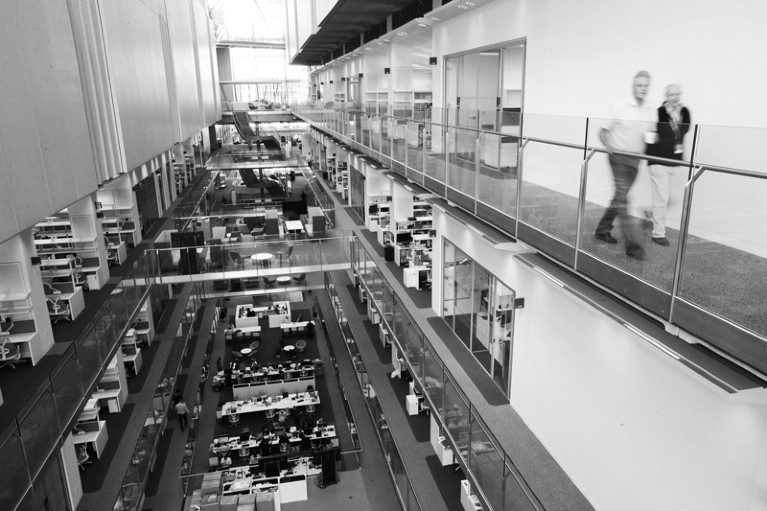
Scientists at the Crick Institute in London have complained about noise.Credit: Daniel Leal-Olivas/AFP/Getty
In 1797, an unexpected visitor to the English cottage of the poet Samuel Taylor Coleridge became a literary metaphor for unwanted distraction that disturbs creativity. The arrival of the so-called Person from Porlock, Coleridge wrote, caused him to forget the rest of Kubla Khan — the words of which he had been busy transcribing after they came to him in a productive dream — and the poem ends incomplete after 54 lines.
Porlock is almost 200 miles from central London, but plenty of people are still knocking on the doors of the Francis Crick Institute, which opened as a base for biomedical research in the capital last year. And some of them are bringing distraction. Scientists working there, in spaces arranged around a central atrium, have complained that the open-plan design is too noisy and they can’t concentrate.
Teething troubles? Probably, and the Crick is far from alone in trying to balance the promised benefits of open-plan office space — collaboration and idea sharing — with the inevitable downsides, including disturbances and lack of privacy. For although the trend in recent years has been firmly towards open-plan design (offices are much more modern-looking and cheaper without all those bulky internal dividing walls), evidence is mounting that such workplaces typically come with a drop in productivity.
Asked what bothers them, open-plan workers say that they resent being on display and grumble about temperature, but they most commonly complain about noise. And their most distracting noise — simply defined as unwanted sound — is often the human voice. (Not all office sounds are considered noise, and some workers say that they find the clatter of keyboards motivating and reassuring.)
To explain the distracting nature of overheard speech, most acoustics experts rely on the changing-state hypothesis, which suggests that sound that arrives in a series of contrasting segments is harder to ignore, and so more likely to be considered noise, than steady sound. Hence a series of spoken words, with intonation, emphasis and pauses, takes attention away from a task more than does a constant drone of air conditioning.
Importantly for open-plan offices, acoustic design theory assumes that as more voices are added to the noise, the distracting peaks, troughs and gaps start to overlap, cancelling and smoothing each other out. At a certain point, simultaneous voices merge into non-segmented babble. So, a single speaker makes distracting background noise, but several speakers, in theory, produce a more soothing background sound.
Not convinced? Some experts agree with you. This year, architects at the University of Sydney in Australia published a challenge to the way in which their colleagues account and allow for unwanted speech in open-plan offices. Specifically, they argue that the relevant international standard — ISO 3382-3:2012 — is flawed because it rigidly follows this acoustic-design logic and assumes that the most problematic noise is the voice of a single speaker (M. Yadav et al. Appl. Acoust. 126, 68–80; 2017). In tests, the architects found that combining four voices made the effect worse for an unfortunate worker asked to sit at a desk and concentrate. Differences between the separate voices might themselves act to segment the sound, the authors suggest.
What’s to be done? Some scientists at the Crick (like workers in countless offices around the world) have been spotted wearing chunky headphones. Music can bring its own distractions (any sensory input that demands attention must drain cognitive power), but the overall effect is complicated because it can also serve as a powerful influence on motivation. What’s more, as any office drone who has tried it will confirm, people are less likely to approach you if you are wearing headphones, whether music is playing or not. So an open-plan office of workers with headphones on would seem to go against the hoped-for creative cooperation of chance collaboration.
Even unmolested concentration and effort, of course, is no guarantee of success — in science or in anything else. Some scholars claim that Coleridge got stuck on Kubla Khan and then invented the Person from Porlock to excuse its fragmentary composition. That might be true — but go on, keep the sounds, noise and babble down a bit. Some of us are trying to think.

 Europe’s superlab: Sir Paul’s cathedral
Europe’s superlab: Sir Paul’s cathedral




